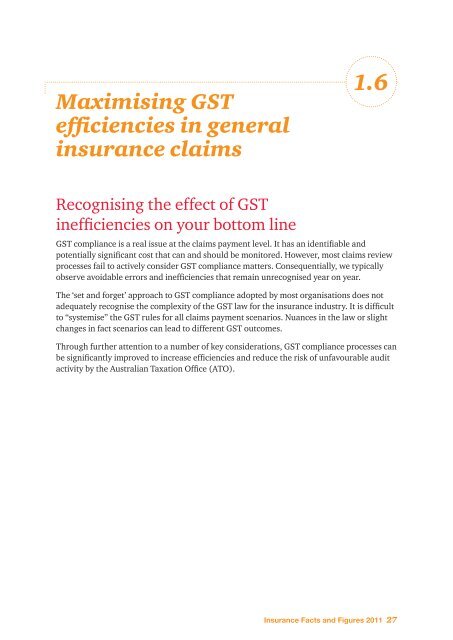PwC Insurance Facts and Figures 2011 - PricewaterhouseCoopers
PwC Insurance Facts and Figures 2011 - PricewaterhouseCoopers
PwC Insurance Facts and Figures 2011 - PricewaterhouseCoopers
You also want an ePaper? Increase the reach of your titles
YUMPU automatically turns print PDFs into web optimized ePapers that Google loves.
Maximising GST<br />
efficiencies in general<br />
insurance claims<br />
1.6<br />
Recognising the effect of GST<br />
inefficiencies on your bottom line<br />
GST compliance is a real issue at the claims payment level. It has an identifiable <strong>and</strong><br />
potentially significant cost that can <strong>and</strong> should be monitored. However, most claims review<br />
processes fail to actively consider GST compliance matters. Consequentially, we typically<br />
observe avoidable errors <strong>and</strong> inefficiencies that remain unrecognised year on year.<br />
The ‘set <strong>and</strong> forget’ approach to GST compliance adopted by most organisations does not<br />
adequately recognise the complexity of the GST law for the insurance industry. It is difficult<br />
to “systemise” the GST rules for all claims payment scenarios. Nuances in the law or slight<br />
changes in fact scenarios can lead to different GST outcomes.<br />
Through further attention to a number of key considerations, GST compliance processes can<br />
be significantly improved to increase efficiencies <strong>and</strong> reduce the risk of unfavourable audit<br />
activity by the Australian Taxation Office (ATO).<br />
<strong>Insurance</strong> <strong>Facts</strong> <strong>and</strong> <strong>Figures</strong> <strong>2011</strong> 27
















